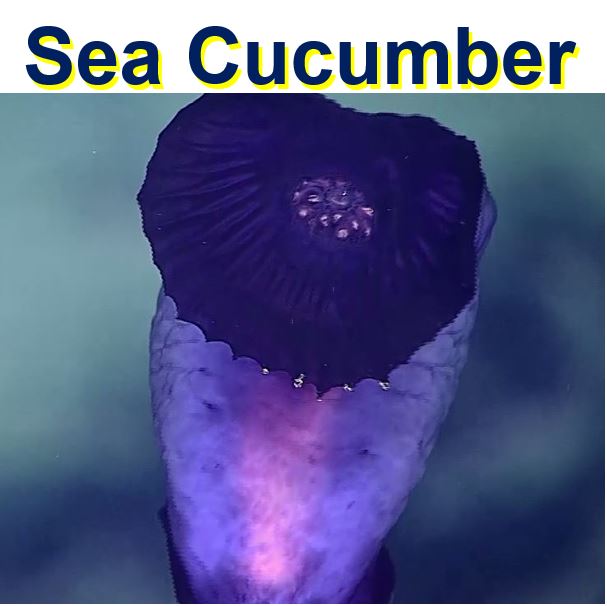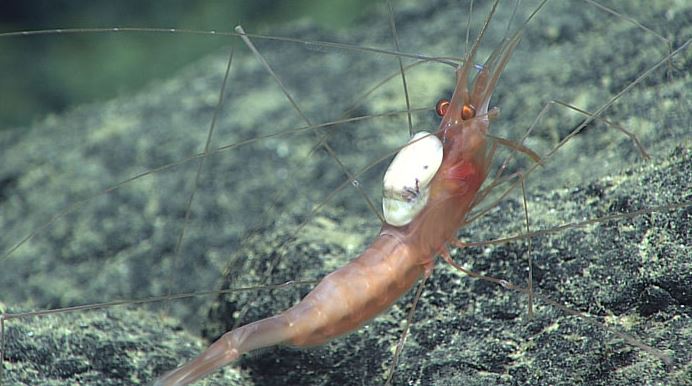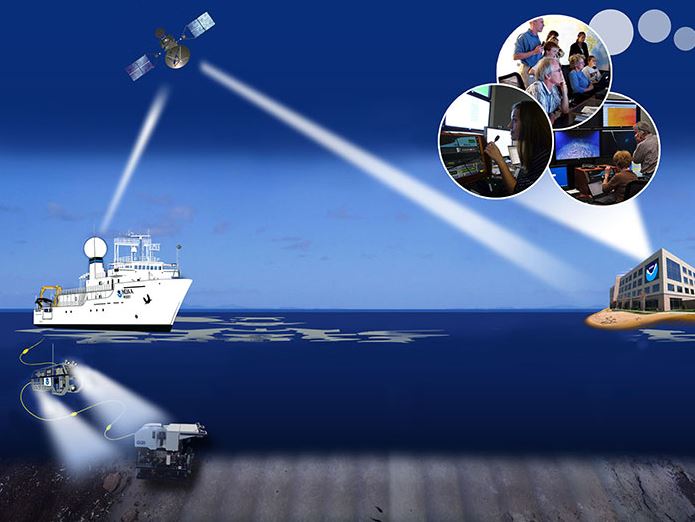A live video feed from the deepest place on Earth – several miles below the surface of the Pacific Ocean – shows a spectacular jellyfish and other marine life, including tripod fish, eels, anemones, sponges, sea cucumbers and eels swimming around in the Mariana Trench.
The Mariana Trench is the deepest part of Earth’s oceans, located in the western Pacific Ocean, to the east of the Mariana Islands, between Japan, the Philippines and Australia. The 2,550-km-long trench reaches a maximum known depth of 10,994 metres, or 6.831 miles (36,070 feet).
A sea vehicle, operated remotely, is swimming around at the bottom of the sea around the Mariana Trench, trying to find out more about one of the most mysterious and remote places on Earth.
 This spectacular jellyfish eats, sleeps and reproduces deep down in the sea in total darkness. Scientists once assumed that life would be sparse at the bottom of the Mariana Trench, but the opposite is true – it is teeming with life. (Image: noaa.gov)
This spectacular jellyfish eats, sleeps and reproduces deep down in the sea in total darkness. Scientists once assumed that life would be sparse at the bottom of the Mariana Trench, but the opposite is true – it is teeming with life. (Image: noaa.gov)
Abundant fauna and flora on ocean floor
The live video footage, which is being narrated by a team of scientists, shows the abundant fauna and flora on the ocean floor. Who would have thought that such a remote part of our planet would be teeming with life.
The remotely operated vehicle, which is tethered to the National Oceanic and Atmospheric Administration’s ship Okeanos Explorer, is now several weeks into a 3-month expedition – from 20th April to 1oth July.
The 69-day expedition includes three cruise legs to conduct mapping and ROV (remotely operated vehicle) operations in the deep waters of the MTMNM (Marianas Trench Marine National Monument) and CNMI (Commonwealth of the Northern Mariana Islands).
According to the National Oceanic and Atmospheric Administration:
“The primary expedition goal is to acquire baseline information in deepwater areas to support science and management needs in and around the Monument and other protected places. Operations will focus on understanding the diversity and distribution of deepwater habitats in and around the CNMI and MTMNM.”
 This deep-sea holothurian (sea cucumber) was observed swimming on Dive 05 at Fina Nagu Caldera D. Deep-sea holothurians usually swim to avoid being eaten and physical danger. (Image: oceanexplorer.noaa.gov)
This deep-sea holothurian (sea cucumber) was observed swimming on Dive 05 at Fina Nagu Caldera D. Deep-sea holothurians usually swim to avoid being eaten and physical danger. (Image: oceanexplorer.noaa.gov)
The mission and the live stream have become extremely popular across the world, with thousands of people tuning in throughout the day and night.
Animals never seen before on live stream
Scientists say that a lot of what we can see on the live stream has never been seen by anybody before.
In the coming weeks, scientists expect to explore bottomfish habitats, mud volcanoes, new hydrothermal vent sites, seamounts, subductions zone areas, deep-sea coral and sponge communities, and trench areas.
All these fascinating features are within the US exclusive economic zone. ROV dives include high-resolution visual surveys and limited collections of geological and biological sampling.
 Marine biologists were unable to identify the parasite living on the back of this shrimp. Parasites are one of the most poorly described groups of animals in the world. (Image: oceanexplorer.noaa.gov)
Marine biologists were unable to identify the parasite living on the back of this shrimp. Parasites are one of the most poorly described groups of animals in the world. (Image: oceanexplorer.noaa.gov)
The stunningly beautiful jellyfish (video at bottom of page) was filmed at a depth of about 3,700 metres as scientists explored the informally named Enigma Seamont near the Marianas Trench Marine National Monument.
The hydromedusa (jellyfish type creature) has been identified by scientists as belonging to the genus Crossota. Note the two sets of tentacles – long and short.
At the start of the video, you can see that the long tentacles are even and extended outward and the bell is motionless, suggesting that the animal is about to ambush its prey. Inside the bell, the radial canals in red are connecting points for what appear to be gonads in bright yellow.
 The Okeanos Explorer uses telepresence technology to transmit data in real time to a shore-based hub where the footage is then transmitted to a number of Exploration Command Centers located around the United States as well as to any Internet-enabled device. (Image: oceanexplorer.noaa.gov)
The Okeanos Explorer uses telepresence technology to transmit data in real time to a shore-based hub where the footage is then transmitted to a number of Exploration Command Centers located around the United States as well as to any Internet-enabled device. (Image: oceanexplorer.noaa.gov)
The scientists say they never know exactly what they will find, so tune in to the live feeds to see what they discover next!
According to the Okeanos Explorer team:
“Use of the live streams is an important component of the Okeanos Explorer’s mission. Depending on the exploration and operations at hand, content and availability of the video feeds will change. Tune in often to catch all the action aboard America’s Ship for Ocean Exploration!”
Use the Okeanos Explorer mobile app
If you want to watch the Okeanos Explorer live video feeds, but don’t fancy being stuck in front of your computer monitor all the time, there is an app – for iOS and Android devices – you can download.
The mobile app will allow you to bring the excitement of ocean discovery directly to your tablet or smartphone. The app also provides information on where Okeanos Explorer is, plus updates on the dives.
Video – Deep sea Jellyfish
This incredibly beautiful jellyfish was spotted during Dive 4 of the 2016 Deepwater Exploration of the Marianas expedition on 24th April 2016, while exploring the ‘Enigma Seamount’ about 3,700 metres below the surface of the ocean.
Discover more from Market Business News
Subscribe to get the latest posts sent to your email.

